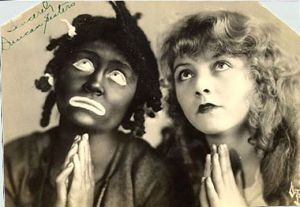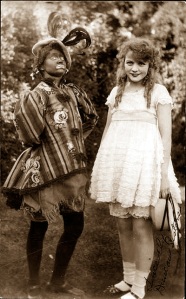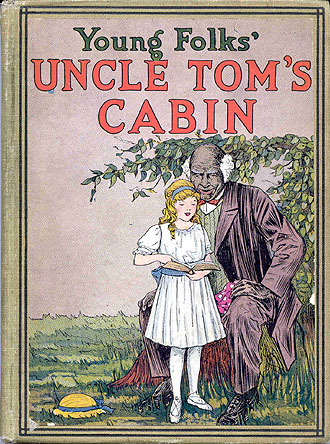Visual statements narrate identity in order for the viewers to understand multimodality, grasp the connections between language and image, and in turn, comprehend the connections between language, image, and identity (Humphreys, 2011). What is multimodality? Well, multimodality points to the truth value of credibility that we supply to the narratives and images that comprise our world, or particular contexts (Humphreys, 2011). In the introduction of Gunther Kress and Theo van Leeuwen’s, Reading Images: The Grammar of Visual Design, the theorists explain that “like linguistic structures, visual structures point to particular interpretations of experience and forms of social interaction” (2). Humans form conceptual frameworks and make meaning, which become internalized and acted out overtime. Like Kress and van Leeuwen, I am interested in how social actors are represented in a specific context. We can see this idea of multimodality in the Duncan Sisters advertisement below, featuring Topsy and Little Eva, two extremely popular, mass-marketed characters that came out of Harriet Beecher Stowe’s, Uncle Tom’s Cabin. It is clear that images of Topsy and Little Eva used in the early 20th century advertising draw from specific character traits that define each character.
and image, and in turn, comprehend the connections between language, image, and identity (Humphreys, 2011). What is multimodality? Well, multimodality points to the truth value of credibility that we supply to the narratives and images that comprise our world, or particular contexts (Humphreys, 2011). In the introduction of Gunther Kress and Theo van Leeuwen’s, Reading Images: The Grammar of Visual Design, the theorists explain that “like linguistic structures, visual structures point to particular interpretations of experience and forms of social interaction” (2). Humans form conceptual frameworks and make meaning, which become internalized and acted out overtime. Like Kress and van Leeuwen, I am interested in how social actors are represented in a specific context. We can see this idea of multimodality in the Duncan Sisters advertisement below, featuring Topsy and Little Eva, two extremely popular, mass-marketed characters that came out of Harriet Beecher Stowe’s, Uncle Tom’s Cabin. It is clear that images of Topsy and Little Eva used in the early 20th century advertising draw from specific character traits that define each character.
The Duncan Sisters were an acting duo who became popular in the 1920s with their act as Topsy and Eva, which is illustrated in the advertisement to the left. Interestingly, there is both racial and sexual grammar depicted in the advertisement. Firstly, we can see that the Duncan sisters used blackface in their performances; “a technique that bypasses the need to find an actual African American to behave in the buffoonish manner by white folks” (Humphreys, 2011). Secondly, it is clear that Topsy represents a certain form of African-American female sexual identity, just as Little Eva represents a certain form of white female sexual identity. Hence, both female actors in the Duncan sister advertisement are positioned as representation of race in relation to sexuality.
Historically, black bodies have been labelled as sexual bodies. White women were socially constructed as civilized, modest, and sexually pure, while black women were considered to be uncivilized, immodest, and sexually promiscuous (Musial, 2010). These racist and sexist ideologies are present in the illustrations of Topsy and Little Eva in the Duncan sister’s advertisement examined. In one of her demonstrations, Professor Humphrey’s argued that Little Eva demands attention with her direct gaze at the reader, while Topsy demands nothing as she stands and makes herself available to be possessed by the viewer’s gaze was intriguing (Humphrey). Not only does the language that Humphrey’s used provide a sexual connotation, but when analyzing Topsy’s impersonator, one can definitely notice the strong presence of sexual imagery. The main difference between the Duncan sister’s representation of Topsy and Little Eva is in their poses. On the left side of the image stands Topsy, with her legs spread apart and chest pushed out, which seems to have caused her dress to rise in the front. Thus, she has provided the viewer to see what appears to be dirt on her legs or torn stockings. However, her stance is not the only element that calls for attention and creates awareness of her sexual identity. For instance, her blurred face causes Topsy to be washed out of the picture, allowing Little Eva to remain the dominant focus of the piece. Therefore, Little Eva is the centre of attention in order for the product to sell. Furthermore, the colour saturation is very bright and draws the reader’s attention to Topsy’s dishevelled clothing and overall unkempt appearance. Therefore, the Topsy impersonator in the advertisement depicts a stereotypical representation of a black female, who is identified as uncivilized, inhibited, and sexually promiscuous. On the right side of the image stands Little Eva in a plain, yellow sundress, with her legs together, blush on her face, and poised stance. Positioned in opposition to Topsy, the white sister portrayed as Little Eva exemplifies modesty, cleanliness, and purity. All of these examples enforce that Topsy represents female African-American identity, which was deemed as sexualized and dirty, whereas Little Eva is a representation of her white identity, which was considered pure and modest.
Check out this video clip I found of the Duncan Sisters performance (start at the 4:25 mark):
The examination of the Duncan sister’s advertisement is simply one example of an image that enforces the contrasting differences between the two characters of Topsy and Little Eva. Furthermore, even though images do not have the same grammar as language, it is evident that they can tell stories.
 American Apparel is a fashion company that claims to represent the everyday woman. To the left, we have an American Apparel blackface image that appeared in a magazine. Just like the Duncan sister’s advertisement, this image draws on specific character traits that define that woman. Similar to Topsy’s appearance, the colour saturation is very bright in this ad. We can also see that there is both racial and sexual grammar depicted in the advertisement. Clearly, racist imagery continues to be incorporated in advertisements today.
American Apparel is a fashion company that claims to represent the everyday woman. To the left, we have an American Apparel blackface image that appeared in a magazine. Just like the Duncan sister’s advertisement, this image draws on specific character traits that define that woman. Similar to Topsy’s appearance, the colour saturation is very bright in this ad. We can also see that there is both racial and sexual grammar depicted in the advertisement. Clearly, racist imagery continues to be incorporated in advertisements today.




























Great analysis, very accurate. And thanks for the video – I am actually writing a chapter on the Duncan sisters and vaudeville right now!